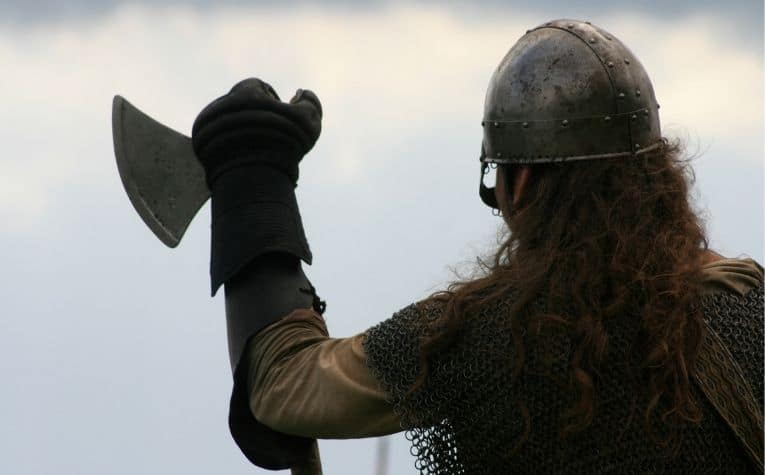The Vikings and Celts are both groups of past people living in Europe. Both groups have their own cultures, history, and significance.
However, some might confuse the Vikings for Celts and consider them Celtic because of the many similarities between the groups.
The Vikings were not technically Celtic, though they share some similarities with the Celts.
Vikings and Celts were two separate groups, though the Celts may have loosely influenced the Vikings.
The two groups were near each other and rivaled each other in 1000 BC.
First, it’s important to understand who the Vikings and the Celts were and what the word Celtic implies.
Below, this article will outline the differences and similarities between the Vikings and the Celts.
In addition, it will discuss the actual classification of the Vikings based on what historians consider to be true.
Also see Were the Vikings Before Jesus Christ? to learn more.

Who Were the Vikings and the Celts?
The Vikings and Celts were two separate groups living in Europe.
The Celts lived between approximately 600 BC and 43 AD (during the Iron Age), and the Viking age was between 800 AD and 1050 AD (during the Bronze Age). Both are of cultural significance in both European and world history.
Who the Vikings Were
The Vikings (sometimes referred to as Norseman or Northman) lived in the Bronze Age of World History.
From 800 AD to the 11th century, they were known for colonizing and taking over large territories in Europe.
Viking can be translated to a word meaning “pirate” or “raider,” which is how the Vikings were known in Europe.
Modern-day Denmark, Sweden, and Norway are where the Vikings originated from.
Through their travels, they began to control many parts of Europe, including:
- England
- Ireland
- Scotland
- Wales
- Iceland
- Greenland
Eventually, they even explored parts of North America.
Also see Were There African Vikings? to learn more.
Who the Celts Were
The Celts lived from 600 BC to 43 AD. They are the origin of Celtic culture, including its religion, historical events, and cultural beliefs.
The Celts and Celtic culture are most closely associated with modern-day Ireland, Wales, and Scotland.
According to the Oxford dictionary, being Celtic means being “connected with the Celts or their language”. [1]
In discussing pre-modern civilization in Europe, being Celtic means to have originated from the Celtic tribes or speaking the same language. Languages of the Celts included:
- Irish
- Scottish Gaelic
- Welsh
- Breton
- Manx
- Cornish
- Gaulish
Though it’s possible during their overlap of time that some Celts became Vikings or vice versa, the Vikings are not Celtic by definition.
Also see Are Vikings Tattoos Cultural Appropriation? to learn more.

What Are the Similarities Between the Vikings and Celts?
The biggest similarity between the Vikings and Celts is that they are both culturally significant to European and world history.
They were some of the first people living in Europe and had similar pasts. Their cultures may have influenced each other, and they met on many historic occasions.
Geographic Location in Europe of Vikings and Celts
One significant similarity between the Vikings and the Celts is the land they occupied.
The Vikings and Celts controlled and settled in modern Europe’s Ireland, Scotland, and Wales.
It’s important to remember that though they occupied some of the same lands, the Vikings and Celts also had another land they controlled that the opposing group wasn’t on.
Additionally, while there was overlap between the Iron and Bronze Ages when the Vikings and Celts lived, the two had entire histories without the other’s involvement (the Celts before the Vikings and the Vikings after the Celts).
So, while Vikings lived in Ireland at one point, and so did the Celts, they didn’t share the space for very long.
Also see Did the Vikings Have Polygamy? to learn more.
Historical Impact of Vikings and Celts
The Vikings and Celts are similar in their significance as well. Both groups lived in Europe and influenced it with their history, religion, and cultural practices.
In the same way that one might consider the first English settlers to America and the indigenous people similar groups because they occupied the same land at different times, the Vikings and Celts were both early peoples on Europe’s lands.
However, even in the above scenario, there are vast differences between indigenous people who have lived in modern-day American territory and the first European explorers to colonize the land.
The similarities in both cases may overlap here and there but mostly surround the geographic location and historical impact.
There may have been events where the Vikings and Celts were in the same place at the same time, fighting with each other (such as when the Vikings invaded Ireland for the first time). These instances weren’t the norm, however.
Celtic Vikings and Norse-Gaels
As mentioned above, there is the possibility that some Vikings were Celtic in that they decided to settle in Celtic territory and absorb the culture.
These people were considered Norse-Gaels and Celtic Vikings, creating their group of citizens occupying early Europe.
Also see Were the Vikings Before the Romans? to learn more.

What Are the Differences Between the Vikings and Celts?
The differences between the Vikings and Celts are their origins, the periods they were living in, their cultural practices, and even the way they looked.
Though they both lived in Europe – even simultaneously at times – they lived through vastly different historical events with minimal overlap.
The Vikings mostly lived during the Iron Age and were known as strong, even aggressive pirates who took land and colonized other cultures.
The Celts were around during the Bronze Age with some overlap between them and the Vikings, and they are known for settling in lands in Europe that are even now considered lands of modern Celts.
During their history, the Celts had lived in the modern-day:
- Britain
- Ireland
- France
- Spain
- Scotland [2]
Throughout their history, the Vikings have lived in the modern-day:
- Norway
- Scandinavia
- Denmark
- Iceland
- Ireland (near Dublin, Wexford, Waterford, Cork, and Limerick) [3]
Historically, Celts are known for having long red and blonde hair and wearing bright clothes. Additionally, many historical depictions include blue paint that they wore in battle.
As for Vikings, newer DNA evidence suggests they had dark hair and dark eyes, and the classically considered Vikings’ characteristics of blonde hair and blue eyes.
Another significant discovery about the Vikings suggests that the women and men had similar face structures.
The Celtic revival and lasting influence of Celt culture mean that many people would consider themselves modern-day Celts.
However, it’s rare to find a person who considers themselves a modern-day Viking.
Also see Was Ragnar Lodbrok Swedish? to learn more.
Are the Celts Considered Nordic?
The Celts are not considered Nordic. The Viking cultures originated in Scandinavian, Swedish, Danish, and Nordic countries.
Celts and Vikings are not the same and have significant differences not limited to the time they lived and their cultures.
Vikings, however, are considered by many historians to be Nordic.
Celts are considered, instead, to be Celtic. A group of Vikings settled in Ireland who would have been considered Celtic Vikings or Norse-Gaels, but these are still not considered “Nordic.”
Conclusion
Vikings are not Celtic. Historians consider the Vikings as Nordic, Scandinavian, or Swedish.
